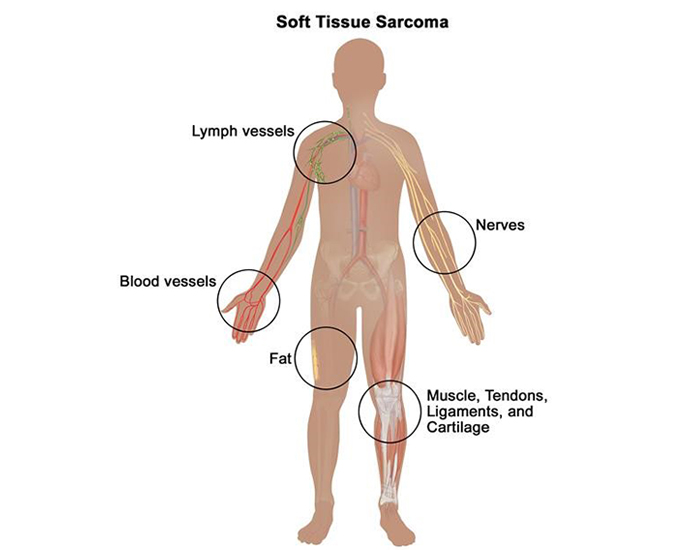Sarcomas
Introduction
A sarcoma is a type of tumor that develops in connective tissue, such as bone, cartilage or muscle. Sarcomas can be benign (noncancerous) or malignant (cancerous). Treatments include surgery, radiation, chemotherapy and thermal ablation.
What are the types of sarcoma?

Bone Tumors
Benign bone tumors
Benign (noncancerous) tumors are even more common than malignant tumors in the musculoskeletal system.
Common types of benign tumors include:
- Osteochondromas.
- Aneurysmal bone cysts.
- Simple bone cysts.
- Fibrous dysplasia.
- Langerhans Cell Histiocytosis.
- Non-ossifying fibromas.
In addition, benign bone tumors can be associated with familial conditions or syndromes, such as MHE (multiple hereditary exostosis), Ollier’s Disease, Maffucci’s Disease or McCune-Albright syndrome.
Benign bone tumors that are more aggressive, such as giant cell tumor or chondromyxoid fibromas, usually require surgery. In these cases, techniques such as synthetic bone graft substitutes are used to rebuild rather than remove bone. Drugs such as denosumab or zolendronic acidare also used to treat specific tumors.
Malignant bone tumors
Though bone tumors are a rare type of cancer (approximately 3,000 cases a year in the United States), there are many different types.
Common types of malignant bone tumors include:
- Osteosarcoma (osteogenic sarcoma).
- Ewing’s sarcoma.
- Fibrosarcoma.
- Chondrosarcoma.
- Multiple myeloma.
More than one-third of bone sarcomas are diagnosed in patients under the age of 35 years old; many are diagnosed in children.
Metastatsis to bones
As opposed to primary bone sarcoma (cancer that starts in the bone), metastasis to bone starts in another location (such as an organ) and travels to the bone. This cancer can come from any organ, most often thyroid, lung, kidney, breast or prostate.
When cancer from a distant organ spreads to the skeleton, it can create structural problems in the bone that may lead to greater pain and reduced functioning.
Soft Tissue Tumors
Benign soft tissue tumors
Benign soft tissue tumors are very common (fewer than 5% of all lumps or bumps discovered are cancerous). Many of these tumors can be monitored regularly, but some have to be removed by surgery. Some benign tumors, such as desmoid tumors, may require treatment from the medical oncology, radiation oncology or interventional radiology teams, all of which work closely together.
The most common types of benign soft tissue tumors include:
- Desmoid tumors.
- Large arteriovenous malformations.
- Lipomas (fatty tumours).
- Pigmented villonodular synovitis.
- Schwannomas.
- Synovial chondromatosis.
Malignant soft tissue tumors
Soft tissue sarcomas begin in the muscle or other connective tissues of the body. Unlike bone tumors, most soft tissue sarcomas occur in adults, though certain types, such as rhabdomyosarcoma, are found mostly in children.
Some of the most common types of soft tissue sarcomas include:
- Desmoplastic small round cell tumors.
- Gastrointestinal stromal tumor (GIST).
- Leiomyosarcoma.
- Liposarcoma.
- Malignant peripheral nerve sheath tumor.
- Rhabdomyosarcoma.
- Synovial sarcoma.
- Undifferentiated pleomorphic sarcoma.
Genitourinary Sarcomas
Genitourinary sarcomas are rare cancerous (malignant) tumors that develop in the genitals or urinary tract. Genitourinary sarcomas are less than 5% of all types of sarcomas, and they tend to develop more in children than in adults. They typically develop in:
- The bladder
- The kidney
- The ureters (the tubes that drain urine from the kidneys into the bladder)
- The urethra (the tube that drains urine from the bladder to outside of the body)
- The male reproductive system (prostate, testicles, and penis)
- The vagina
There are no clear symptoms associated with genitourinary sarcomas in the early stages. However, you can feel a painless mass by touch. As the mass grows bigger and presses against the nearby nerves, you will start to feel some pain or soreness.
Symptoms of larger genitourinary sarcomas includes
Symptoms of larger genitourinary sarcomas include:
- Blood in urine (hematuria) or trouble urinating
- Sores, discharge, or skin changes in the genital-urinary area
Of all genitourinary sarcomas types, bladder sarcomas tend to fare better with treatment. The presence of blood in the urine makes the early detection of bladder sarcomas possible. The overall survival rate for a patient with any sarcoma depends on the type, location, size, and stage of the tumor.
Uterine Leomyosarcomas are common in adult females. Can present with per vaginal bleeding or lower abdominal pain.
Treatment Of Sarcoma
In cancer care, different types of doctors often work together to create a patient’s overall treatment plan that combines different types of treatments. This is called a multidisciplinary team.
Surgery
Surgery is the removal of the tumor and some surrounding healthy tissue during an operation. Small low-grade sarcomas can usually be effectively removed by surgery alone. Those that are high grade and larger than 2 inches (5 cm) are often treated with a combination of surgery and radiation therapy. Radiation therapy or chemotherapy may be used before surgery to shrink the tumor and make removal easier. They also may be used during and after surgery to destroy any remaining cancer cells.
Rarely, for patients with a very large tumour involving the major nerves and blood vessels of the arm or leg, surgical removal of the limb, called amputation, is required to control the tumor.
Radiation therapy
A radiation therapy regimen, or schedule, usually consists of a specific number of treatments given over a set period of time.
Radiation therapy may be done before surgery to shrink the tumor so that it may be more easily removed. Or it may be done after surgery to remove any cancer cells left behind. Radiation treatment may make it possible to do less surgery, often preserving critical structures in the arm or leg if the sarcoma is located in one of those places
Therapies using medication
Systemic therapy is the use of medication to destroy cancer cells. This type of medication is given through the bloodstream to reach cancer cells throughout the body. Systemic therapies are generally prescribed by a medical oncologist, a doctor who specializes in treating cancer with medication.
Common ways to give systemic therapies include an intravenous (IV) tube placed into a vein using a needle or in a pill or capsule that is swallowed (orally).
The types of systemic therapies used for sarcomas include:
- Chemotherapy: Chemotherapy is the medication that keeps cancer cells from growing, dividing, and making more cells.
- Targeted therapy: Targeted therapy is a treatment that targets cancer’s specific genes, proteins, or the tissue environment that contributes to cancer growth and survival, usually by blocking the action of proteins in cells called kinases. This type of treatment blocks the growth and spread of cancer cells and limits damage to healthy cells.
- Immunotherapy: Immunotherapy, also called biologic therapy, is designed to boost the body’s natural defenses to fight the cancer. It uses materials made either by the body or in a laboratory to improve, target, or restore immune system function.
We, at Dr Puranik Cancer Clinic, offer the best sarcoma treatment with all the latest treatment options being available like chemotherapy, targeted therapy, biological therapy and immunotherapy.
